Have you ever tried to relax or focus, only to be interrupted by the hum or rattle of your home’s systems? You’re not alone. Many homeowners face the challenge of disruptive sounds that can affect everything from daily comfort to creative projects like video production or home theater setups.
These issues often stem from your hvac system, which can produce sounds through ductwork or central units. Whether it’s a persistent hum or unexpected rattling, these noises can be more than just annoying—they can impact your home’s efficiency and your peace of mind.
But here’s the good news: there are effective ways to address this. From modern upgrades to simple soundproofing techniques, you can transform your space into a quieter, more efficient environment. Let’s explore how you can tackle this dual challenge and reclaim your home’s comfort.
Key Takeaways
- Disruptive sounds from your home systems can affect comfort and productivity.
- Common sources include ductwork and central units in your hvac system.
- Modern upgrades and soundproofing methods can significantly reduce these issues.
- Addressing these problems improves both efficiency and peace of mind.
- Simple solutions like proper maintenance and design adjustments can make a big difference.
Understanding Your Noisy HVAC System
Does the constant hum or rattle from your home’s air system disrupt your peace? You’re not alone. Many homeowners face this issue, and it often stems from the central unit or ductwork. Understanding the source of these sounds is the first step toward a quieter home.
Common HVAC Noise Sources
Your system can produce a variety of sounds, from buzzing to rattling. Central units often create vibrations that travel through walls. Ductwork, if poorly sealed, can amplify these noises. Forced air movement can also contribute to unwanted sound intrusions.
Here’s a breakdown of common noise sources:
| Noise Type | Possible Cause |
|---|---|
| Buzzing | Loose parts or debris in the unit |
| Rattling | Unsecured ductwork or vibrations |
| Hissing | Air leaks in the duct system |
| Screeching | Worn-out fan motor or belt |
How Noise Impacts Your Home Comfort
These sounds aren’t just annoying—they can affect your daily life. Light sleepers may find it hard to rest. Professionals working from home might struggle with focus. Even activities like watching TV or recording videos can be disrupted by the constant hum or rattle.
For example, a poorly sealed duct can let in external noises, making it harder to enjoy a quiet evening. Similarly, vibrations from the central unit can travel through walls, creating a distracting environment.
By identifying these issues, you can take the first step toward a quieter, more comfortable home. In the next section, we’ll explore practical strategies to address these noise problems effectively.
Implementing the HVAC Noise Reduction Guide
Ever felt your calm moment shattered by an unexpected hum from your home’s systems? You’re not alone. Many homeowners face this issue, but the good news is, there are practical ways to address it. Let’s dive into some effective strategies to create a quieter, more comfortable space.
Key Strategies for Noise Control
Reducing unwanted sounds starts with understanding the right techniques. Here are some proven methods:
- Add insulation: Wrapping your ductwork with high-quality material can significantly reduce sound transmission.
- Use damping materials: Applying these to your central unit helps control vibrations and minimizes noise.
- Seal air leaks: Properly sealing your ductwork prevents whistling and hissing sounds.
These strategies not only reduce noise but also improve your home’s overall efficiency. For example, adding insulation to your ductwork can block up to 90% of unwanted sounds, according to industry research.
Real-Life Scenarios and Experiences
Many homeowners have successfully transformed their spaces. Take Sarah, for instance. She noticed a constant hum from her central unit, which made it hard to focus on her work-from-home tasks. By wrapping the unit with damping material and insulating her ductwork, she created a quieter environment. “It’s like night and day,” she shared. “I can finally concentrate without distractions.”
Expert Tips Over Coffee
Here’s some friendly advice, the kind you’d hear over coffee: Start with small changes. For example, check your ductwork for leaks and seal them with mastic tape. If you’re dealing with vibrations, consider using isolation pads under your unit. These simple steps can make a big difference.
| Strategy | Impact |
|---|---|
| Insulating ductwork | Reduces sound transmission by up to 90% |
| Using damping materials | Controls vibrations and minimizes noise |
| Sealing air leaks | Prevents whistling and hissing sounds |
By implementing these strategies, you can enjoy a quieter, more peaceful home. Whether you’re working, relaxing, or spending time with loved ones, these changes will enhance your comfort and well-being.
Identifying Noise Sources and Patterns
Ever noticed how some rooms in your home feel noisier than others? Pinpointing the source of these sounds is the first step toward a quieter environment. Whether it’s a faint rumble or a persistent hiss, understanding where the noise originates can help you address it effectively.
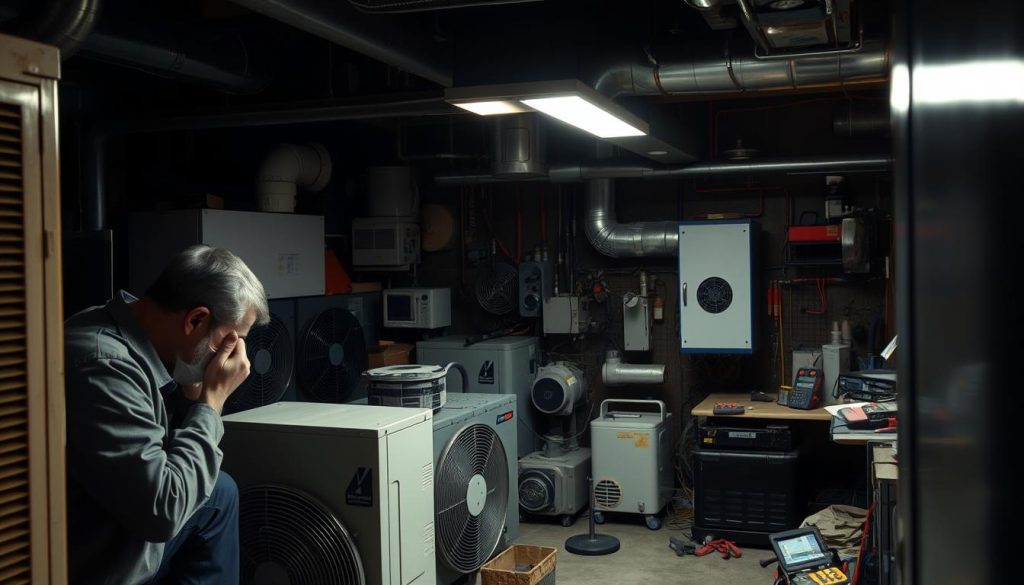
Central Unit vs. Ductwork Noise
Noises from your central unit often sound like a low hum or rattle. These sounds can travel through walls, making them noticeable in multiple rooms. On the other hand, ductwork noises tend to be sharper, like whistling or hissing, especially if there are air leaks.
For example, a loose panel on your central unit might create a rhythmic thumping. Meanwhile, a poorly sealed duct can produce a high-pitched whistle every time the system runs. Recognizing these differences helps you target the right fixes.
Recognizing Vibration and Airflow Issues
Vibrations are another common culprit. Even a slight vibration from your central unit can amplify into a distracting rumble. Airflow imbalances, like blocked vents or dirty filters, can also create turbulence, leading to whistling or rattling sounds.
Take John’s experience, for instance. He noticed a faint hum in his living room but couldn’t figure out the source. After inspecting his system, he discovered a loose fan blade causing the vibration. Tightening it restored peace to his home.
| Noise Type | Possible Source |
|---|---|
| Low Hum | Central Unit |
| Whistling | Air Leaks in Ductwork |
| Rattling | Loose Parts or Vibrations |
| Hissing | Airflow Imbalances |
By identifying these patterns, you can take targeted steps to reduce unwanted sounds. In the next section, we’ll explore soundproofing solutions designed to counteract these issues and restore tranquility to your environment.
Soundproofing Your HVAC Unit and Ductwork
Imagine settling into your favorite chair, only to be interrupted by an unwelcome hum or rattle. These sounds can disrupt your comfort and make your home feel less peaceful. The good news? There are effective ways to reduce noise and create a quieter environment.
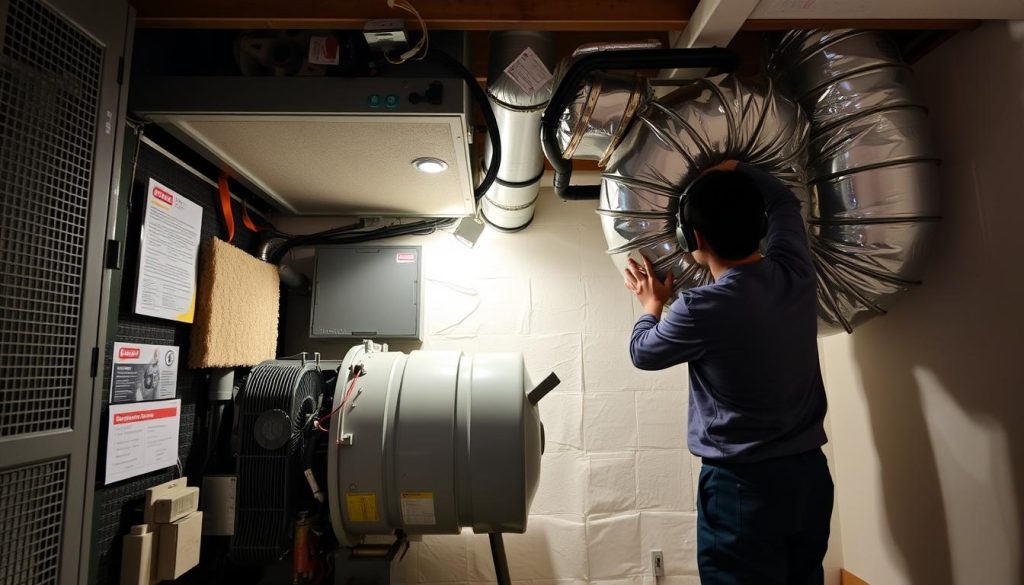
Isolation Pads and Vibration Mounts
One of the simplest ways to reduce noise is by using isolation pads or vibration mounts. These tools absorb vibrations from your unit, preventing them from traveling through walls or floors. Think of them as shock absorbers for your home’s systems.
For example, placing isolation pads under your unit can cut vibration-related sounds by up to 50%. It’s a small change that makes a big difference in your comfort.
Wrapping Units with Damping Materials
Another effective method is wrapping your unit with damping materials. These specialized products act like a warm blanket, absorbing sound waves and preventing them from escaping. Studies show that damping materials can block up to 90% of certain frequencies.
By wrapping your unit, you not only reduce noise but also improve its efficiency. It’s a win-win for your home’s comfort and energy bills.
Building a Dedicated Closet
For a more advanced solution, consider building a dedicated closet for your unit. This space, with its dense walls, acts as a sound barrier, trapping noise before it reaches your living areas. Adding insulation to the closet further enhances its effectiveness.
For instance, a well-designed closet can reduce sound transmission by up to 70%. It’s an investment in your home’s tranquility and long-term comfort.
- Isolation pads: Absorb vibrations and reduce noise by up to 50%.
- Damping materials: Block up to 90% of certain frequencies.
- Dedicated closet: Reduces sound transmission by up to 70%.
By implementing these strategies, you can transform your home into a quieter, more peaceful space. Whether you’re working, relaxing, or spending time with loved ones, these changes will enhance your comfort and well-being.
Sealing Air Leaks and Insulation Techniques
Ever wondered why your home’s system seems louder than it should be? Often, the culprit is air leaks or inadequate insulation. These issues can cause whistling, whooshing, or other unwanted noise that disrupts your peace. The good news? You can tackle this problem with simple DIY fixes or advanced solutions.
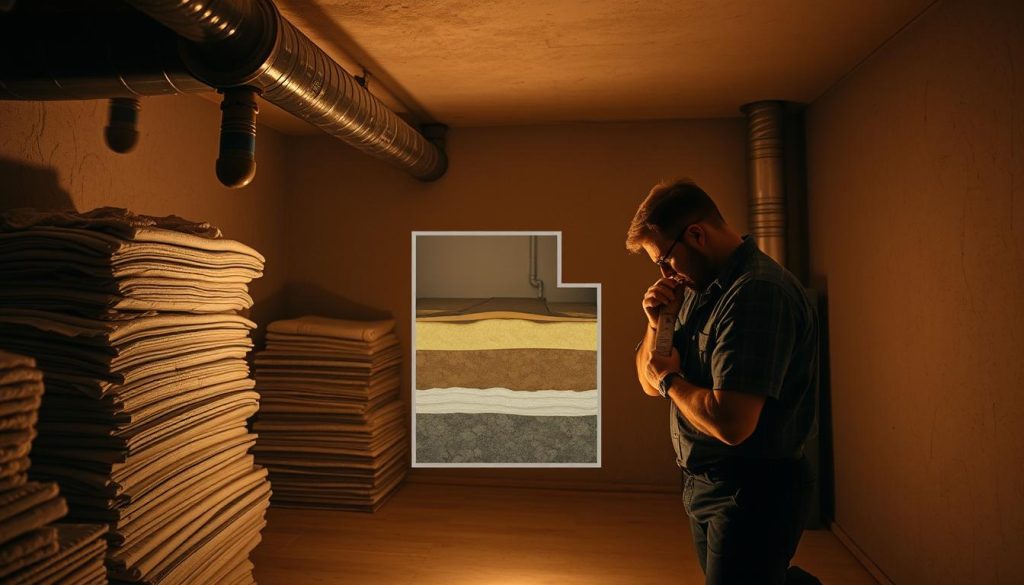
DIY Sealing Solutions
Start with easy fixes that don’t require professional help. One effective method is using expanding foam to seal gaps in your ductwork. This material fills small cracks, preventing air leaks that cause whistling sounds. Another option is mastic tape, which is perfect for sealing larger gaps.
Here’s a quick step-by-step guide:
- Inspect your ducts for visible gaps or cracks.
- Apply expanding foam to small gaps, allowing it to expand and harden.
- Use mastic tape for larger openings, ensuring a tight seal.
These simple steps can significantly reduce unwanted noise and improve your system’s efficiency.
Advanced Insulation Materials
If you’re ready to take things a step further, consider advanced insulation materials. Fiberglass and foam insulation are excellent choices for absorbing sound waves and maintaining proper airflow. Reflective insulation, for example, can reduce cooling costs by reflecting up to 97% of radiant heat.
Here’s a comparison of popular insulation options:
| Material | Benefits |
|---|---|
| Fiberglass | Cost-effective, easy to install, reduces noise by up to 50% |
| Foam | High R-value, expands to fill gaps, blocks up to 90% of sound |
| Reflective | Reflects radiant heat, improves energy efficiency |
By upgrading your insulation, you not only reduce noise but also enhance your home’s energy efficiency. For instance, properly sealed ducts can improve system efficiency by up to 30%.
Whether you choose DIY fixes or advanced materials, addressing air leaks and insulation can transform your home into a quieter, more comfortable space. Optimized airflow and well-sealed ducts lead to quieter operation, making your home a peaceful retreat.
Optimizing Fan Speed and Airflow Efficiency
Have you ever been in the middle of a quiet moment, only to hear an unexpected hum from your system? This common issue often stems from improper fan speed settings. Adjusting your fan speed can be a game-changer for both efficiency and quiet operation.
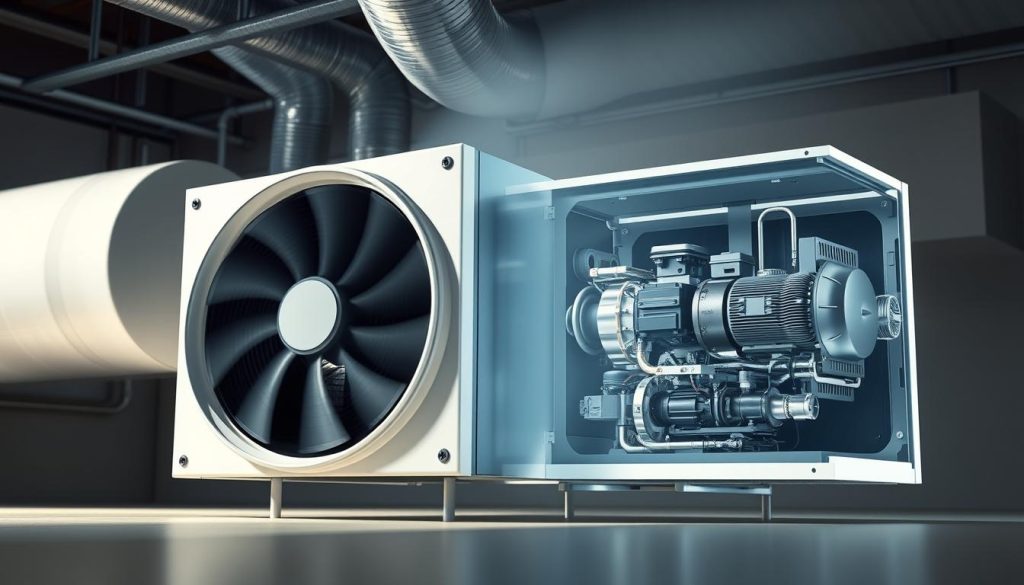
Finding the right balance between speed and efficiency is key. Too high, and your unit may produce unnecessary hvac noise. Too low, and it might struggle to maintain comfort. The good news? Modern systems offer solutions to this problem.
Balancing Efficiency and Quiet Operation
Variable speed blowers are a great example of innovation in this area. Unlike traditional single-speed fans, these blowers adjust their speed based on demand. This not only reduces noise reduction but also improves energy efficiency. For instance, a small reduction in fan speed can lead to significant noise reduction without sacrificing performance.
Here’s how it works: Variable speed blowers operate at lower speeds most of the time, ramping up only when needed. This minimizes vibrations and keeps your unit running smoothly. According to industry research, this approach can reduce noise by up to 99% in some cases.
Here are some practical steps to optimize your system:
- Check your fan settings: Ensure your fan is set to auto or a lower speed for quieter operation.
- Upgrade to a variable speed blower: This solution offers better control over airflow and noise levels.
- Inspect for vibrations: Loose parts can amplify noise. Tighten any components as needed.
| Fan Speed Adjustment | Impact |
|---|---|
| 10% Reduction | 19% Drop in Static Pressure |
| 20% Reduction | 27% Cut in Horsepower |
| Variable Speed Blower | Up to 99% Noise Reduction |
By following these steps, you can enjoy a quieter, more efficient system. Whether you’re working from home or relaxing, these adjustments will enhance your comfort and peace of mind.
Innovative Noise-Dampening Solutions and DIY Ideas
Have you ever been interrupted by a sudden whoosh or hum while trying to enjoy your space? These sounds can disrupt your peace, but with a little creativity, you can transform your home into a quieter haven. Let’s explore some innovative solutions and DIY ideas to help you achieve just that.
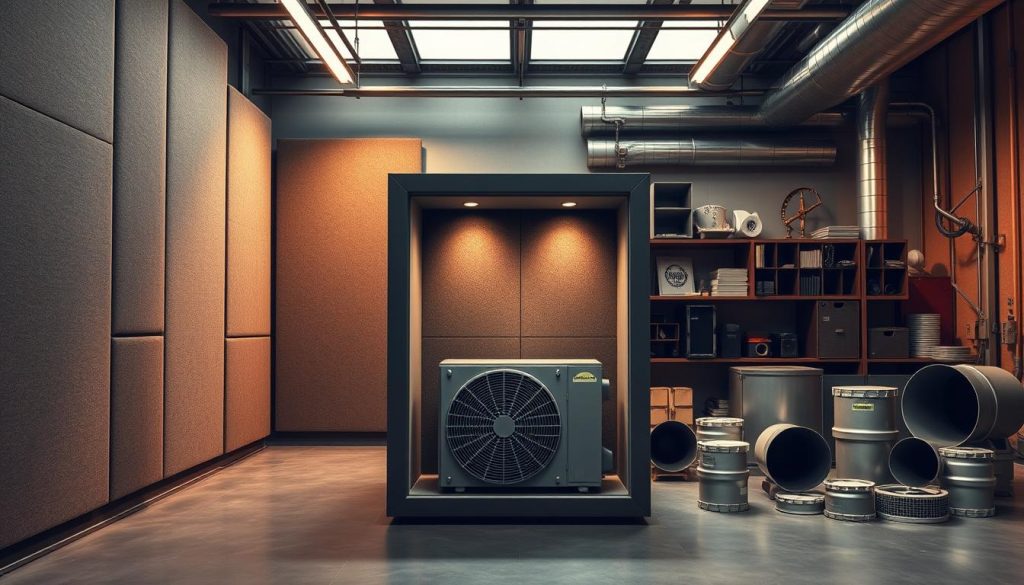
Using Duct Silencers and Soundproof Blankets
One effective method to reduce unwanted sounds is by installing duct silencers. These devices are designed to muffle noise traveling through your ductwork, cutting down on whistling or hissing sounds. For example, a properly installed silencer can reduce sound transmission by up to 50%.
Soundproof blankets are another great option. These heavy, dense materials can be wrapped around your air conditioning unit or ducts to absorb sound waves. They’re easy to install and can block up to 60% of noise, making them a practical choice for immediate relief.
Building a Sound Maze
For a more creative approach, consider building a sound maze around your ductwork. This involves arranging household materials like foam panels or cardboard in a zigzag pattern to deflect noise. It’s a fun and cost-effective way to reduce sound without major renovations.
Imagine turning a noisy corner of your home into a quiet retreat with just a few simple materials. This method not only works but also adds a unique touch to your space.
Incorporating Sound-Absorbing Furnishings
Your choice of furnishings can also play a big role in maintaining a quiet environment. Rugs, heavy drapes, and upholstered furniture absorb sound waves, reducing echoes and background noise. For instance, a thick area rug can cut down on footstep sounds, while heavy curtains can block external noise.
Here’s a quick tip: Place a bookshelf filled with books against a shared wall. The dense materials act as a natural sound barrier, enhancing your space’s tranquility.
Importance of Regular Maintenance
While these solutions are effective, regular maintenance is key to ensuring they work long-term. Check your ductwork for leaks, tighten loose components, and clean your air conditioning unit to prevent noise from creeping back in.
By combining these innovative ideas with consistent maintenance, you can enjoy a quieter, more peaceful home. Whether you’re working, relaxing, or spending time with loved ones, these changes will make a noticeable difference.
Industry Data and Research on HVAC Noise Reduction
Have you ever considered how advancements in technology are making your home quieter and more efficient? The latest research and industry trends reveal exciting developments in soundproof solutions. From innovative materials to smarter installation techniques, these advancements are transforming how we address sound wave issues in modern systems.
Recent studies highlight the effectiveness of modern soundproof measures. For example, fiberglass insulation can absorb up to 99% of sound waves striking its surface. This makes it a top choice for reducing unwanted noise in ductwork and central units.
Today’s Trends and Research Insights
One of the most significant trends is the use of variable speed blowers. These devices adjust their speed based on demand, reducing noise and improving efficiency. According to industry research, this approach can cut noise levels by up to 99% in some cases.
Another breakthrough is the development of micro-perforated plate technology. Used in duct silencers, this innovation effectively reduces noise emissions. Startups like Redu-Sone are leading the way with these advanced solutions.
Here’s a quick look at some key findings:
- Fiberglass insulation: Absorbs up to 99% of sound waves.
- Variable speed blowers: Reduce noise by up to 99%.
- Micro-perforated plates: Cut noise emissions effectively.
Case studies also demonstrate the real-world impact of these technologies. For instance, a recent project showed that upgrading to variable speed blowers reduced noise levels by 50% in a residential building. This not only improved comfort but also enhanced energy efficiency.
Here’s a comparison of popular soundproof solutions:
| Solution | Noise Reduction |
|---|---|
| Fiberglass Insulation | Up to 99% |
| Variable Speed Blowers | Up to 99% |
| Micro-Perforated Plates | Effective noise control |
These advancements are not just theoretical—they’re making a real difference in homes and businesses. By staying informed about these trends, you can make smarter choices for your installation and enjoy a quieter, more efficient space.
Maintaining Your System for Long-Term Quiet
Keeping your home’s systems running smoothly doesn’t have to be a hassle. With a little care and attention, you can enjoy a quieter, more efficient space for years to come. Regular maintenance is the key to reducing noise and ensuring your system operates at its best.
Regular Checkups and Preventative Maintenance
Routine inspections are essential for keeping your system quiet and efficient. Simple steps like checking for loose parts or cleaning filters can make a big difference. For example, replacing a dirty filter can improve airflow and reduce noise caused by obstructions.
Here are some easy maintenance tips:
- Inspect your panel: Tighten any loose screws or connections to prevent vibrations.
- Clean ducts and vents: Remove debris that could cause whistling or rattling sounds.
- Lubricate moving parts: This keeps your system running smoothly and quietly.
By following these steps, you can avoid common issues and enjoy the benefit of a quieter home.
When to Consider Upgrades and Replacements
Even with regular maintenance, there comes a time when upgrades or replacements are necessary. Older systems may struggle to operate quietly, even with the best care. If you notice persistent loud noises or frequent repairs, it might be time for a change.
Here are some signs to watch for:
| Sign | Action |
|---|---|
| Frequent breakdowns | Consider upgrading to a newer model. |
| Increased energy bills | Replace outdated components for better efficiency. |
| Excessive noise | Invest in modern, quieter technology. |
Upgrading your system not only reduces noise but also improves energy efficiency. For instance, newer models can operate 30-50% quieter than older ones, offering a significant benefit for your home.
By staying proactive, you can enjoy a peaceful, efficient space for years to come. Regular checkups and timely upgrades ensure your system remains a quiet, reliable part of your home.
Conclusion
Transforming your home into a peaceful retreat starts with understanding your system’s components. Small changes, like adding damping materials or checking insulation, can create big waves in improving your space’s comfort. These adjustments not only enhance operation but also boost overall efficiency.
Key components like the compressor and fans play a significant role in maintaining a quiet environment. Regular maintenance ensures these parts function smoothly, reducing disruptions and extending their lifespan. By addressing issues early, you can prevent larger problems down the line.
Take action today by reviewing your system and implementing one or two simple upgrades. Whether it’s sealing air leaks or upgrading to quieter technology, these steps will yield long-term benefits. A quieter home isn’t just a dream—it’s within reach with consistent care and thoughtful improvements.
FAQ
What are the most common sources of noise in my system?
How does noise affect my home environment?
What are some effective strategies to reduce system noise?
How can I soundproof my ductwork?
Are there DIY solutions for quieter operation?
When should I consider upgrading my system?
How do I balance fan speed and airflow for quiet operation?
What are the benefits of regular maintenance?
Can I build a dedicated closet for my unit?
What are the latest trends in noise reduction technology?
Source Links
- HVAC Noise Reduction: Quiet Solutions for Improved Comfort
- How to Reduce HVAC Noise: Effective Air Handler Noise Reduction Strategies
- Microsoft Word – Course – HVAC Systems Noise Control R.doc
- Understanding HVAC Noise: What’s Normal and What’s Not? –
- What Noise is That? 10 Common HVAC Noises Explained – Happy Hiller
- The Ultimate Guide to HVAC Noise Reduction Techniques – Beam Airflow
- HVAC Noise Reduction: Your Guide to a Quieter Home with HVAC in Calgary
- Reducing HVAC Noise: Tips for a Quieter, More Peaceful Home
- HVAC Noise Reduction – Essential Strategies for a Quieter Home
- Identification of Noise Sources and Design of Noise Reduction Measures for a Pneumatic Nail Gun
- HVAC Noise Reduction | Soundproofing Ductwork and Vents
- HVAC Air Vent Noise Reduction
- HVAC Duct System Noise Reduction Techniques
- HVAC Noise Reduction | Soundproofing Ductwork and Vents
- A Complete Guide to Fixing Air Leaks
- Duct Insulation & Sealing: Key to HVAC Efficiency and Safety | Season Control
- How to reduce industrial fan noise, hum or drone without attenuators with improved efficiency
- Fan Curves Explained: A Complete Guide
- Understanding the fan components inside your HVAC system
- How to Soundproof HVAC Systems | Acoustical Surfaces
- HVAC Noise Reduction | Soundproofing Ductwork and Vents
- How to Soundproof a Room or Apartment Affordably and Easily
- Practical Guide to Noise and Vibration Control, Second Edition
- Top 10 HVAC Industry Trends in 2025 | StartUs Insights
- How to Reduce HVAC Noise in Quiet Neighborhoods – One Hour Air Conditioning & Heating Dallas
- Noise Reduction in Commercial HVAC Systems – Diversified HVAC
- HVAC Sound Dampening Solutions for Acoustic Comfort | AirFixture
- Effective HVAC Noise Reduction Tips – www.techstarmechanical.com

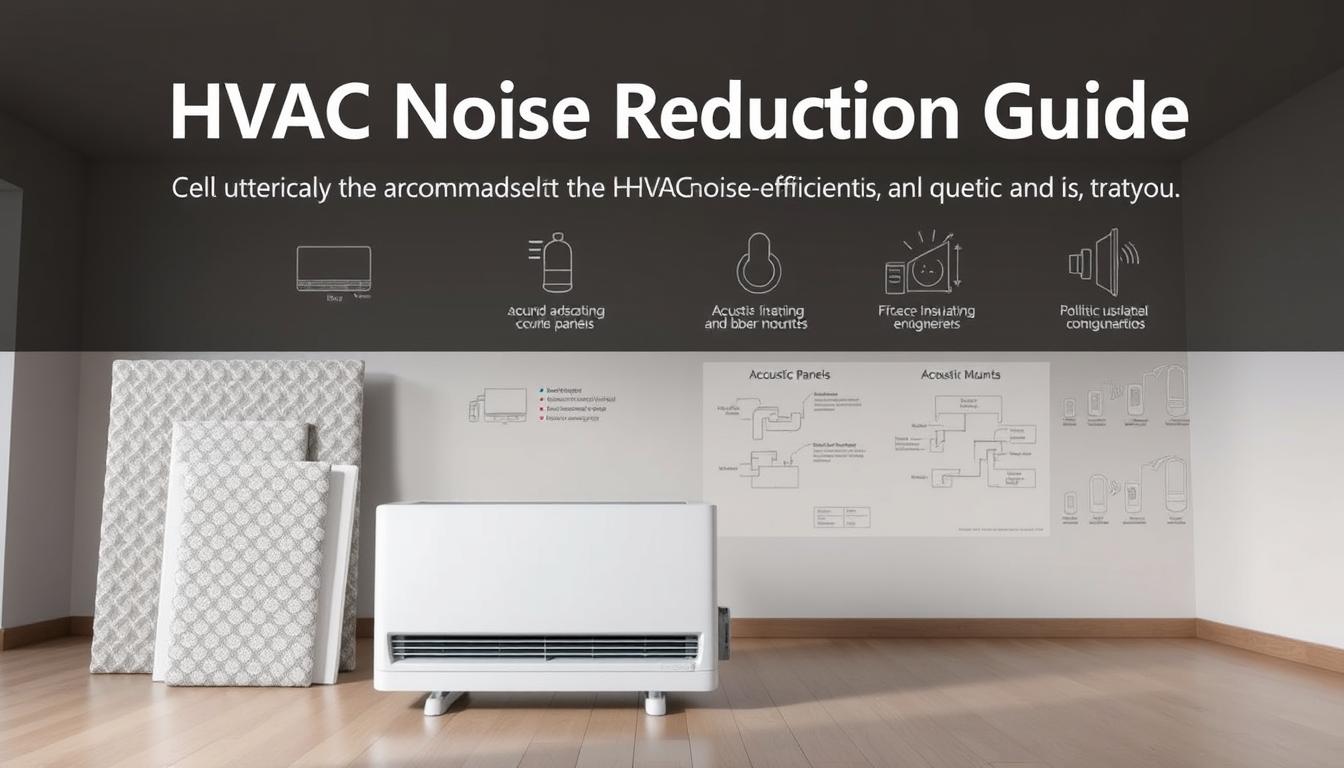

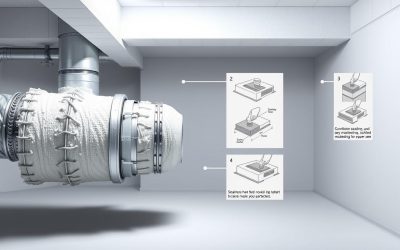
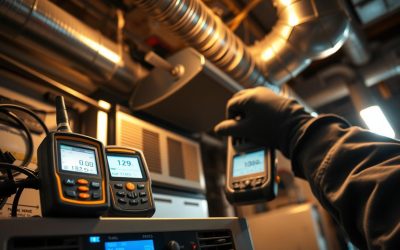
0 Comments